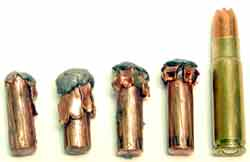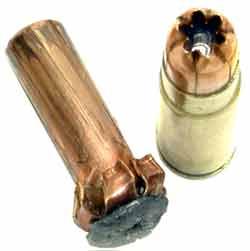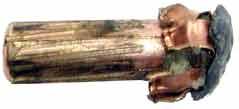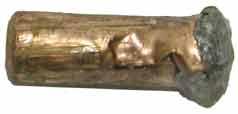Subsonic bullets are useful not only for military covert operations, but for animal control officers and others who need to use a nearly silent or legal suppressed firearm to avoid alarming other animals, upsetting nearby livestock, or bothering the neighbors. Sometimes the use of a suppressed weapon in civilian animal control situations is politically wise, as it allows the necessary use of firearms without attracting undue attention from irrational activist groups. Subsonic bullets in legal suppressed firearms are also fun to shoot for target practice, eliminating the sonic crack that requires hearing protection, distrubs neighbors, and frightens livestock.

| ||||||||||
The equipment necessary to make long range subsonic rifle bullets in calibers from .14 to .458 is:
For lead tip bullets (single shot or revolver), an even more effective design is the X-cut core with Saber Tooth LT-HP design. To make this bullet, change the above items to:
In the X-cut core, a little swage lube is inserted into the X cut prior to a second seating operation with the HP-LT punch. This prevents the X-cut from sticking together, even though it looks as if the cut is closed again by pressing with the HP punch. The bullet jackets for .308 can be Corbin J-30-125 versatile benchrest jackets. For calibers in the .257 to .284 range (anything smaller than 30 and larger than 6mm) the same jacket can be used with one or more JRD-1-S jacket draw dies, and an ET-2-S jacket trim die. For jackets larger than .308, one can use pistol jackets (such as a .44 drawn to 8mm with two JRD-1-S draw dies, and trimmed with an ET-2-S trim die) or copper tubing with the CTJM-1-S tubing jacket maker kit. Copper tubing will need to be thinned or serrated more heavily than a commercial drawn jacket, to give satisfactory expansion. For calibers of 6mm and smaller, the Corbin J-6m-102 jacket can be used, and drawn to 224 for a long, heavy bullet, in some cases without a trim die. For long, heavy 20, 19, or 17 bullets, a Corbin J-22-705 jacket can be used with a JRD-1-S. A trim die may not be required. |
Start writing here...
 The principle problem which subsonic bullet design must overcome is lack of expansion at low velocity. With single shots and revolvers, the tip can be made with exposed lead and a large hollow point cavity. In magazine-fed firearms, the tip needs be strong enough to handle feeding pressures, which often eliminates large hollow point lead tips. Therefore, the jacket needs to come to the end of the bullet, and the hollow point down inside the core, which is inside the jacket (not exposed as in a lead tip).
The principle problem which subsonic bullet design must overcome is lack of expansion at low velocity. With single shots and revolvers, the tip can be made with exposed lead and a large hollow point cavity. In magazine-fed firearms, the tip needs be strong enough to handle feeding pressures, which often eliminates large hollow point lead tips. Therefore, the jacket needs to come to the end of the bullet, and the hollow point down inside the core, which is inside the jacket (not exposed as in a lead tip). At very low velocity, the jacket may prevent expansion even with a good-sized hollow point cavity and a blunt nose. Using a SDD-2 jacket serrator die to put six shallow cuts in the OD of the jacket provides stress-riser lines, so that the bullet will peel back evenly along these slightly weaker points on impact. The cuts need only be .010 to .015 inches deep in order to provide excellent performance even at velocities as low as 750-800 fps with proper sized hollow cavity and nose shape, with the .300 Whisper using Corbin J-30-125 jackets.
At very low velocity, the jacket may prevent expansion even with a good-sized hollow point cavity and a blunt nose. Using a SDD-2 jacket serrator die to put six shallow cuts in the OD of the jacket provides stress-riser lines, so that the bullet will peel back evenly along these slightly weaker points on impact. The cuts need only be .010 to .015 inches deep in order to provide excellent performance even at velocities as low as 750-800 fps with proper sized hollow cavity and nose shape, with the .300 Whisper using Corbin J-30-125 jackets.




About Subsonic bullets